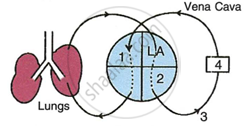Advertisements
Advertisements
प्रश्न
The table below is designed to indicate the transport of certain substance in our body. Fill in the
blanks with suitable answers.
| Substance | From | To |
| Lungs | Whole body | |
| Carbon dioxide | ||
| Urea | ||
| Digested carbohydrates |
Intestines | |
| Target organs |
उत्तर
| Substance | From | To |
| Oxygen | Lungs | Whole body |
| Carbon dioxide | Whole body | Lungs |
| Urea | Whole body | Kidneys |
| Digested carbohydrates | Intestines | Whole body |
| Hormones | Endocrine glands | Target organs |
APPEARS IN
संबंधित प्रश्न
Haemoglobin is present in ______ cells.
Why is blood needed by all the parts of a body?
Name the following:
The kind of blood cells which can squeeze out through the walls of one category of blood vessels.
Differentiate between members of the following pairs with reference to the aspect asked within bracket:
artery and vein (type of blood primarily flowing through)
What is haemoglobin? State the consequences of deficiency of haemoglobin in our bodies.
Fill in the blanks with suitable words given below:
The two lower chambers of the heart are called ______.
Write a short note on the human heart.
Given below is the simplified pathway of the circulatory system:
(i) Name the blood vessels marked 1 to 8.
(ii) Name the chamber of the heart which:
(a) Receives blood from ‘1’.
(b) Pumps blood into blood vessel ‘8’.
(iii) Mention two structural differences between blood vessels ‘7’ and ‘2’.
Name the Following
The enzyme which converts fibrinogen to fibrin.
Given diagram is a schematic representation of the circulatory system in humans. Study the same and answer the questions that follow:
 |
- Label the parts 1 and 4 indicated in the diagram.
- Which of the above mentioned number is the thickest artery? Also write its name.
- Mention the number and chamber of the heart which has the thickest muscular wall.
- Which of the above numbers/structures has the maximum number of blood capillaries?
- Draw neat and labelled diagrams of the transverse section of vena cava and the part numbered as 3. Make sure to show the structural differences between these two in the diagram.
